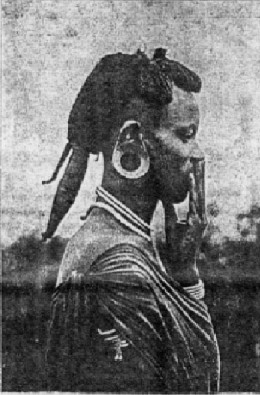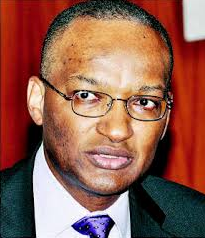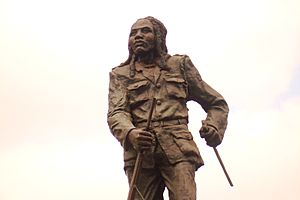Kikuyu people facts for kids
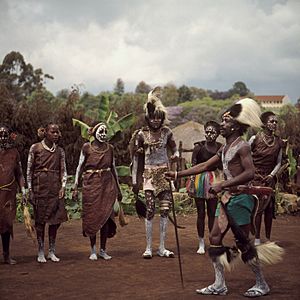 |
|
| Total population | |
|---|---|
| 8,148,668 | |
| Regions with significant populations | |
| Kenya | |
| Languages | |
| Gĩgĩkũyũ, Kiswahili and English | |
| Religion | |
| Christianity, Agikuyu Religion, Islam and Irreligious | |
| Related ethnic groups | |
| Embu, Meru, Mbeere, Kamba, Sonjo and Dhaiso |
| Person | MũGĩkũyũ |
|---|---|
| People | AGĩkũyũ |
| Language | Gĩkũyũ |
| Country | Bũrũrĩ Wa Gĩkũyũ |
The Kikuyu (also Agĩkũyũ/Gĩkũyũ) are a Bantu ethnic group native to Central Kenya. At a population of 8,148,668 as of 2019, they account for 17.13% of the total population of Kenya, making them the largest ethnic group in Kenya.
The term Kikuyu is derived from the Swahili form of the word Gĩkũyũ. Gĩkũyũ is derived from the word mũkũyũ which means sycamore fig (mũkũyũ) tree". Hence Agĩkũyũ in the Kikuyu language translates to "Children Of The Big Sycamore". The alternative name Nyũmba ya Mũmbi, which encompasses Embu, Gikuyu, and Meru, translates to "House of the Potter" (or "Creator").
Contents
History
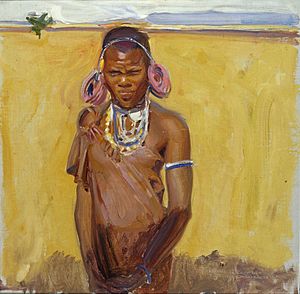
Origin
The Kikuyu belong to the Northeastern Bantu branch. Their language is most closely related to that of the Embu and Mbeere. Geographically, they are concentrated in the vicinity of Mount Kenya.
The exact place that the Northeast Bantu speakers migrated from after the initial Bantu expansion is uncertain. Some authorities suggest that the Kikuyu arrived in their present Mount Kenya area of habitation from earlier settlements further to the north and east, while others argue that the Kikuyu, along with their closely related Eastern Bantu neighbors the Embu, Meru, Mbeere, and Kamba moved into Kenya from points further north.
From archaeological evidence, their arrival at the northern side of Mt. Kenya dates to around the 3rd century, as part of the larger group known as Thagicu. By the 6th century, there was a community of Agikuyu newly established at Gatung'ang'a in Nyeri. The Agikuyu established themselves in their current homeland of Mt. Kenya region by the 13th century.
The nation and its pursuits
Before the establishment of East Africa Protectorate in 1895, the Agĩkũyũ preserved geographic and political power from almost all external influence for many generations; they had never been subdued. Before the arrival of the British, Arabs involved in slave trading and their caravans passed at the southern edges of the Agĩkũyũ nation. Slavery as an institution did not exist amongst the Agĩkũyũ, nor did they make raids for the capture of slaves. The Arabs who tried to venture into Agĩkũyũ land met instant death. Relying on a combination of land purchases, blood-brotherhood (partnerships), intermarriage with other people, and their adoption and absorption, the Agĩkũyũ were in a constant state of territorial expansion. Economically, the Agĩkũyũ were great farmers and shrewd businesspeople. Besides farming and business, the Agĩkũyũ were involved in small scale industries with professions such as bridge building, string making, wire drawing, and iron chain making. The Agĩkũyũ had a great sense of justice (kĩhooto).
Social and political life
The Agĩkũyũ nation was divided into nine clans. Each clan traced its lineage to a single female ancestor and a daughter of Mumbi. The clans were not restricted to any particular geographical area, they lived side by side. Some clans had a recognised leader, others did not. However, in either case, real political power was exercised by the ruling council of elders for each clan. Each clan then forwarded the leader of its council to the apex council of elders for the whole community. The overall council of elders representing all the clans was then led by a headman or the nation's spokesman.
1888–1945
The traditional way of life of Agikuyu was disrupted when they came into contact with the British around 1888. British explorers had visited the region prior the "Scramble for Africa", and now various individuals moved to establish a colony in the region, noting the abundant and fertile farmland. Although initially non-hostile, relationships between the Agikuyu and the Europeans soon turned violent: Waiyaki Wa Hinga, a leader of the southern Agikuyu, who ruled Dagoretti who had signed a treaty with Frederick Lugard of the British East Africa Company (BEAC) burned down Lugard's fort in 1890.
Following severe financial difficulties of the British East Africa Company, the British government on 1 July 1895 established direct Crown rule through the East African Protectorate, subsequently opening in 1902 the fertile highlands to European emigrants. The Agikuyu, upset at the waves of emigrants, enforced a policy of killing any of their own that collaborated with the colonial government. When disputes with white settlers and the Agikuyu became violent (usually over land issues), the settlers would employ Maasai tribesmen together with some colonial troops to carry out their fighting for them. The Maasai had historically negative relations with the Agikuyu, and thus were willing to take up arms against them. The various conflicts between the settlers and the Agikuyu often resulted in defeat for the latter, thanks to their inferior weaponry. The Agikuyu, having been unsuccessful in their conflicts with the European settlers and the colonial government, turned to political means as a method of resolving their grievances.
Kenya served as a base for the British in the First World War as part of their effort to capture the German colonies to the south, which were initially frustrated. At the outbreak of war in August 1914, the governors of British East Africa (as the Protectorate was generally known) and German East Africa agreed to a truce in an attempt to keep the young colonies out of direct hostilities. However, Lt. Col Paul von Lettow-Vorbeck took command of the German military forces, determined to tie down as many British resources as possible. Completely cut off from Germany, von Lettow conducted an effective guerrilla warfare campaign, living off the land, capturing British supplies, and remaining undefeated. He eventually surrendered in Zambia eleven days after the Armistice was signed in 1918. To chase von Lettow-Vorbeck, the British deployed Indian Army troops from India and then needed large numbers of porters to overcome the formidable logistics of transporting supplies far into the interior by foot. The Carrier Corps was formed and ultimately mobilised over 400,000 Africans, contributing to their long-term politicisation.
The experiences gained by Africans in the war, coupled with the creation of the white-dominated Kenya Crown Colony, gave rise to considerable political activity in the 1920s which culminated in Archdeacon Owen's "Piny Owacho" (Voice of the People) movement and the "Young Kikuyu Association" (renamed the "East African Association") started in 1921 by Harry Thuku (1895–1970), which gave a sense of nationalism to many Kikuyu and advocated civil disobedience. Thuku's campaign against the colonial government was short-lived. He was exiled to Kismayu the following year, and it was not until 1924 that the Kikuyu Central Association (KCA) was formed to carry on with Thuku's campaign. From 1924, the Kikuyu Central Association (KCA), with Jomo Kenyatta as its Secretary General focused on unifying the Kikuyu into one geographic polity, but its project was undermined by controversies over ritual tribute, land allocation, and support for Thuku. The KCA sent Kenyatta to England in 1924 and again in 1931 to air their grievances against the colonial government and its policies.
By the 1930s, approximately 30,000 white settlers lived in Agikuyu country and gained a political voice because of their contribution to the market economy. The area was already home to over a million members of the Kikuyu nation, most of whom had been pushed off their land by the encroaching European settlers, and lived as itinerant farmers. To protect their interests, the settlers banned the production of coffee, introduced a hut tax, and landless workers were granted less and less land in exchange for their labour. A massive exodus to the cities ensued as their ability to provide a living from the land dwindled.
In the Second World War (1939–45) Kenya became an important military base. For the Agikuyu soldiers who took part in the war as part of the King's African Rifles (KAR), the war stimulated African nationalism and shattered their conceptions of Europeans. Meanwhile, on the political front, in 1944 Thuku founded and was first chairman of the multi-ethnic Kenya African Study Union (KASU).
1945–1963
In 1946 KASU became the Kenya African Union (KAU). It was a nationalist organisation that demanded access to white-owned land. KAU acted as a constituency association for the first black member of Kenya's legislative council, Eliud Mathu, who had been nominated in 1944 by the governor after consulting with the local Bantu/Nilotic elite. The KAU remained dominated by the Kikuyu ethnic group. In 1947 Jomo Kenyatta, the former president of the moderate Kikuyu Central Association, became president of the more aggressive KAU to demand a greater political voice for the native inhabitants. The failure of the KAU to attain any significant reforms or redress of grievances from the colonial authorities shifted the political initiative to younger and more militant figures within the African trade union movement, among the squatters on the settler estates in the Rift Valley and in KAU branches in Nairobi and the Kikuyu districts of central province.
By 1952, under Field Marshal Dedan Kimathi, the Kenya Land and Freedom Army (Mau Mau) launched an all-out revolt against the colonial government, the settlers and their Kenyan allies. By this time, the Mau Mau were fighting for complete independence of Kenya. The war is considered by some the gravest crisis of Britain's African colonies The capture of rebel leader Dedan Kimathi on 21 October 1956 signalled the ultimate defeat of the Mau Mau Uprising, and essentially ended the military campaign although the state of emergency would last until 1959. The conflict arguably set the stage for Kenyan independence in December 1963.
1963–present
Since the proclamation of the Republic of Kenya, after colonial rule in Kenya came to an end in 1963, the Agikuyu now form an integral part of the Kenyan nation. They continue to play their part as citizens of Kenya, helping to build their country. However, some Kenyans resent their incorrectly perceived superior economic status, a resentment sometimes vented through political violence, as happened in 1992, 1997 and 2007 Kenyan elections.
Genetics
According to a Y-Chromosome DNA study by Wood et al. (2005), around 73% of Gĩkũyũs belong to the common paternal haplogroup E1b1a. The remainder carry other clades: 19% E1b1b with E-M293 contributing 11%, 2% A, and 2% B.
In terms of maternal lineages, Gĩkũyũs closely cluster with other Northeast Bantu speaking groups like the Sukuma. Most belong to various Africa-centered mtDNA macro-haplogroup L lineages such as L0f, L3x, L4g and L5 per Castrì et al. (2009). According to Salas et al. (2002), other Gĩkũyũs largely carry the L1a clade, which is one of the African mtDNA Haplogroups.
Culture
Language
Gĩkũyũs speak the Gĩkũyũ language as their native tongue, which is a member of the Bantu language family. Additionally, many speak Swahili and English as lingua franca, the two official languages of Kenya.
The Gĩkũyũ are closely related to some Bantu communities due to intermarriages prior to colonization. These communities are the Embu, Meru, and Akamba people who also live around Mt. Kenya. Members of the Gĩkũyũ family from the greater Kiambu (commonly referred to as the Kabete) and Nyeri districts are closely related to the Maasai people also due to intermarriage prior to colonization. The Gĩkũyũ people between Thika and Mbeere are closely related to the Kamba people who speak a language similar to Gĩkũyũ. As a result, the Gĩkũyũ people that retain much of the original Gĩkũyũ heritage reside around Kirinyaga and Murang'a regions of Kenya. The Murang'a district is considered by many to be the cradle of the Gĩkũyũ people and as such, Gĩkũyũ's from the Murang'a area are considered to be of a purer breed.
Literature
Until 1888, the Agikuyu literature was purely expressed in folklore. Famous stories include The Maiden Who Was Sacrificed By Her Kin, The Lost Sister, The Four Young Warriors, The Girl who Cut the Hair of the N'jenge, and many more.
When the European missionaries arrived in the Agikuyu country in 1888, they learned the Kikuyu language and started writing it using a modified Roman alphabet. The Kikuyu responded strongly to missionaries and European education. They had greater access to education and opportunities for involvement in the new money economy and political changes in their country. As a consequence, there are notable Kikuyu literature icons such as Ngũgĩ wa Thiong'o and Meja Mwangi. Ngũgĩ wa Thiong'o's literary works include Caitani Mutharabaini (1981), Matigari (1986) and Murogi wa Kagogo (Wizard of the Crow (2006)) which is the largest known Kikuyu language novel having been translated into more than thirty languages.
Music
Traditional Kikuyu music has existed for generations up to 1888, when colonialism disrupted their life. Before 1888 and well into the 1920s, Kikuyu music included Kibaata, Nduumo and Muthunguci. Cultural loss increased as urbanization and modernization impacted on indigenous knowledge, including the ability to play the mũtũrĩrũ – an oblique bark flute. Today, music and dance are strong components of Kikuyu culture. There is a vigorous Kikuyu recording industry, for both secular and gospel music, in their pentatonic scale and western music styles such as "Mathwiti Maigi Ngai!".
Cinema
Kikuyu cinema and film production are a very recent phenomenon among the Agikuyu. They have become popular only in the 21st century. In the 20th century, most of the Agikuyu consumed cinema and film produced in the west. Popular Kikuyu film productions include comedies such as Machang'i series and Kihenjo series. Recently, Kenyan television channels have increased greatly and there are channels that broadcast programs in the Kikuyu language.
Cuisine
Typical Agĩkũyũ food includes Yams, sweet potatoes, Gītheri (maize and beans, after corn was introduced to Africa), Mūkimo (mashed green peas and potatoes), Kīmitū (mashed beans and potatoes), Irio (mashed dry beans, corn and potatoes), Mūtura (sausage made using goat intestines, meat and blood), Ūcūrū (fermented porridge made from flour of corn, millet or sorghum) roast goat, beef, chicken and cooked green vegetables such as collards, spinach and carrots.
Religion
Although Gĩkũyũs historically adhered to indigenous faiths, most are Christians today, of varying denominations, as well as various syncretic forms of Christianity. A third of the Kikuyu practice Islam, notably through Arab, Indian and Persian missionaries since trade with the rest of East Africa.
A small group of Kĩkũyũ, numbering about 60 people in 2015, practice Judaism in the town of Kusuku. While they practice a normative form of Judaism (similar to Conservative Judaism), they are not a recognized part of any larger Jewish group.
Religious and cultural discord
In April 2018, the Presbyterian Church of East Africa made a resolution to prohibit its members from the Kikuyu cultural rite known as Mburi cia Kiama and this triggered disturbances among devotees in the region of Mount Kenya. The Mburi cia Kiama entails the slaughtering of goats and advising men on how to become respected elders. When this process is over, they join different kiamas (groups). It is in these groups that they are given advice on issues like marriage, the Kikuyu culture and community responsibilities. Members of the church were given the ultimatum to renounce the cultural practice or to leave the church's fold.
See also
 In Spanish: Kĩkũyũ para niños
In Spanish: Kĩkũyũ para niños


